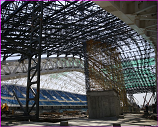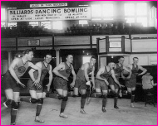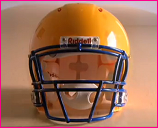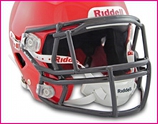Posted on June 19th, 2014 by Mary Lord
 In this activity, elementary students in grades 3 to 5 learn about reverse engineering and how to collect and represent data graphically by investigating different balls and their abilities to bounce.
In this activity, elementary students in grades 3 to 5 learn about reverse engineering and how to collect and represent data graphically by investigating different balls and their abilities to bounce.
Read More
Filed under: Class Activities, Grades K-5 | Comments Off on Ball Bounce Experiment
Tags: balls, data, graph, Materials Engineering, Mathematics, Reverse Engineering, soccer, Sports
Posted on January 21st, 2014 by Mary Lord
 It takes host cities a lot of time, money, and engineering to prepare for the Olympics, and Sochi, the Russian seaside resort that will welcome athletes and fans from around the world this February, is no exception. Along with luge runs and ice arenas, the area’s 218 Olympic projects include a new high-speed rail and seaport.
It takes host cities a lot of time, money, and engineering to prepare for the Olympics, and Sochi, the Russian seaside resort that will welcome athletes and fans from around the world this February, is no exception. Along with luge runs and ice arenas, the area’s 218 Olympic projects include a new high-speed rail and seaport.
A recent Businessweek article estimated the total at $51 billion, making Russia’s games the costliest in history
Read More
Filed under: Special Features | Comments Off on Sochi’s Big Olympics Dig
Tags: arena, Civil Engineering, Environmental Engineering, infrastructure, Olympics, Safety engineering, ski lift, snow, Sochi, Sports, stadium, train, Transportation, Winter Olympics
Posted on July 13th, 2012 by Mary Lord
 In this lesson, students in grades 3 to 12 explore how engineers incorporate the latest materials and manufacturing techniques to improve the performance of sports equipment by constructing a functional racquet out of everyday materials that can volley against another team’s racquet at least six times.
In this lesson, students in grades 3 to 12 explore how engineers incorporate the latest materials and manufacturing techniques to improve the performance of sports equipment by constructing a functional racquet out of everyday materials that can volley against another team’s racquet at least six times.
Read More
Filed under: Class Activities, Grades 6-8, Grades 9-12, Grades K-5 | Comments Off on Lesson: Tennis, Anyone?
Tags: Class Activities, Design, Grades 6-8, Grades 9-12, Grades K-5, Olympics, Sports, Sports Engineering, tennis
Posted on May 14th, 2012 by Mary Lord
 From Lady Gaga’s glowing, LED-encrusted gown to lightweight body armor and high-tech sports apparel, engineered fabrics are turning up well beyond the fashion world. ASEE’s Prism magazine highlights some innovative examples.
From Lady Gaga’s glowing, LED-encrusted gown to lightweight body armor and high-tech sports apparel, engineered fabrics are turning up well beyond the fashion world. ASEE’s Prism magazine highlights some innovative examples.
Read More
Filed under: Special Features | Comments Off on Fashion, Form & Function
Tags: athletics, biometric shirt, Bones, concept cast, CuteCircuit, Cybersecurity, dye, equestrian, fabric, fashion, Hidez, high-performance apparel, LED, Materials Engineering, MIAmobi, nanosilver, Nanotechnology, Nike, Olympics, Pedro Nakazato Andrade, racehorse, Sports, textile manufacturing, textiles, Under Armour
Posted on March 20th, 2011 by Mary Lord
 What does basketball have in common with engineering? Plenty, if you’re Rhodes Scholar Reed Doucette, a former University of Southern California stand-out player and student now pursuing a doctorate in mechanical engineering at Oxford.
What does basketball have in common with engineering? Plenty, if you’re Rhodes Scholar Reed Doucette, a former University of Southern California stand-out player and student now pursuing a doctorate in mechanical engineering at Oxford.
Read More
Filed under: Special Features | Comments Off on Feature: Slam Dunk Engineer
Tags: Sports, Sports Engineering
Posted on March 20th, 2011 by Mary Lord
 From long-shot “Cinderella” teams to “field goal” averages and “bracketology,” the NCAA’s annual “March Madness” men’s Division 1 college basketball championship has a host of pet terms and traditions. Here’s a guide to this year’s Big Dance.
From long-shot “Cinderella” teams to “field goal” averages and “bracketology,” the NCAA’s annual “March Madness” men’s Division 1 college basketball championship has a host of pet terms and traditions. Here’s a guide to this year’s Big Dance.
Read More
Filed under: Special Features | Comments Off on Big Dance Basics
Tags: Lesson Plans, Sports, Sports Engineering
Posted on January 31st, 2011 by Jaimie Schock
 In this video, Sport Science takes a deeper look into concussions caused from helmet to helmet collisions. It exams the different factors involved and offers statistics on concussions and collisions in the NFL.
In this video, Sport Science takes a deeper look into concussions caused from helmet to helmet collisions. It exams the different factors involved and offers statistics on concussions and collisions in the NFL.
Read More
Filed under: Web Resources | 2 Comments »
Tags: Biomedical, Biomedical Engineering, Sports, Sports Engineering, Videos
Posted on January 31st, 2011 by Jaimie Schock
 This video from Riddell shows how their protective football helmets are made. The video takes a step-by-step approach and explains how the gear is tested and assembled.
This video from Riddell shows how their protective football helmets are made. The video takes a step-by-step approach and explains how the gear is tested and assembled.
Read More
Filed under: Web Resources | Comments Off on Video: How Helmets Are Made
Tags: Engineering Design Process, Sports, Sports Engineering
Posted on January 30th, 2011 by ASEE
 In this lesson, students in grades 6-8 learn the basic engineering issues related to helmet design, specifically the physics of collisions and the biomechanics considerations of design. Students then identify and solve design challenges, create a poster representation of their solutions, and present them to their peers. Finally, students will learn about the dangers of not wearing a helmet in certain sports.
In this lesson, students in grades 6-8 learn the basic engineering issues related to helmet design, specifically the physics of collisions and the biomechanics considerations of design. Students then identify and solve design challenges, create a poster representation of their solutions, and present them to their peers. Finally, students will learn about the dangers of not wearing a helmet in certain sports.
Read More
Filed under: Grades 6-8, Lesson Plans | Comments Off on Lesson: Safety Gear and Helmets
Tags: Engineering Design, Safety engineering, Sports, Sports Engineering
 In this activity, elementary students in grades 3 to 5 learn about reverse engineering and how to collect and represent data graphically by investigating different balls and their abilities to bounce.
In this activity, elementary students in grades 3 to 5 learn about reverse engineering and how to collect and represent data graphically by investigating different balls and their abilities to bounce.








 It takes host cities a lot of time, money, and engineering to prepare for the Olympics, and Sochi, the Russian seaside resort that will welcome athletes and fans from around the world this February, is no exception. Along with luge runs and ice arenas, the area’s 218 Olympic projects include a new high-speed rail and seaport.
It takes host cities a lot of time, money, and engineering to prepare for the Olympics, and Sochi, the Russian seaside resort that will welcome athletes and fans from around the world this February, is no exception. Along with luge runs and ice arenas, the area’s 218 Olympic projects include a new high-speed rail and seaport. In this lesson, students in grades 3 to 12 explore how engineers incorporate the latest materials and manufacturing techniques to improve the performance of sports equipment by constructing a functional racquet out of everyday materials that can volley against another team’s racquet at least six times.
In this lesson, students in grades 3 to 12 explore how engineers incorporate the latest materials and manufacturing techniques to improve the performance of sports equipment by constructing a functional racquet out of everyday materials that can volley against another team’s racquet at least six times. From Lady Gaga’s glowing, LED-encrusted gown to lightweight body armor and high-tech sports apparel, engineered fabrics are turning up well beyond the fashion world. ASEE’s Prism magazine highlights some innovative examples.
From Lady Gaga’s glowing, LED-encrusted gown to lightweight body armor and high-tech sports apparel, engineered fabrics are turning up well beyond the fashion world. ASEE’s Prism magazine highlights some innovative examples. What does basketball have in common with engineering? Plenty, if you’re Rhodes Scholar Reed Doucette, a former University of Southern California stand-out player and student now pursuing a doctorate in mechanical engineering at Oxford.
What does basketball have in common with engineering? Plenty, if you’re Rhodes Scholar Reed Doucette, a former University of Southern California stand-out player and student now pursuing a doctorate in mechanical engineering at Oxford. From long-shot “Cinderella” teams to “field goal” averages and “bracketology,” the NCAA’s annual “March Madness” men’s Division 1 college basketball championship has a host of pet terms and traditions. Here’s a guide to this year’s Big Dance.
From long-shot “Cinderella” teams to “field goal” averages and “bracketology,” the NCAA’s annual “March Madness” men’s Division 1 college basketball championship has a host of pet terms and traditions. Here’s a guide to this year’s Big Dance. In this video, Sport Science takes a deeper look into concussions caused from helmet to helmet collisions. It exams the different factors involved and offers statistics on concussions and collisions in the NFL.
In this video, Sport Science takes a deeper look into concussions caused from helmet to helmet collisions. It exams the different factors involved and offers statistics on concussions and collisions in the NFL. This video from Riddell shows how their protective football helmets are made. The video takes a step-by-step approach and explains how the gear is tested and assembled.
This video from Riddell shows how their protective football helmets are made. The video takes a step-by-step approach and explains how the gear is tested and assembled. In this lesson, students in grades 6-8 learn the basic engineering issues related to helmet design, specifically the physics of collisions and the biomechanics considerations of design. Students then identify and solve design challenges, create a poster representation of their solutions, and present them to their peers. Finally, students will learn about the dangers of not wearing a helmet in certain sports.
In this lesson, students in grades 6-8 learn the basic engineering issues related to helmet design, specifically the physics of collisions and the biomechanics considerations of design. Students then identify and solve design challenges, create a poster representation of their solutions, and present them to their peers. Finally, students will learn about the dangers of not wearing a helmet in certain sports.